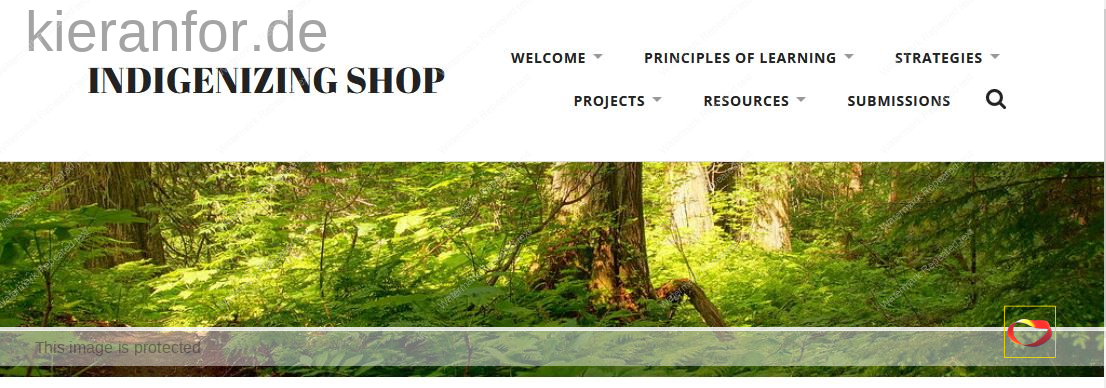Header image: Screenshot of home page of Indigenizing Shop
Jeremy O’Shea is a Tech Ed teacher at Edward Milne Community School, SD#62 Sooke.
In 2021, he completed his MEd at UVic, submitting the following project:
- O’Shea, J. (2021). Implementing Indigenous Education with Technology Education in British Columbia [Unpublished master’s thesis]. University of Victoria.
https://dspace.library.uvic.ca/items/ef417dda-a4d0-42a8-96d6-cba3130e473c
The project was to create “an online website that will act as a resource for technology educators to guide in implementing and intersecting Indigenous education with technology education classes and shops” (p. 4).
That website can be found here: https://indigenizingshop.opened.ca/
∞
CC BY-NC-ND 4.0 [Indigenous OERs? (1)(2)]
- “connections between the First People’s Principles of Learning and social constructivism theory”
- “…builds on the belief that understanding and learning are inherently social”
- “…intersects with the First Peoples Principles of Learning (FPPL), emphasizing community and intergenerationally focused learning”
- “how technology education can be viewed through a holistic lens by incorporating the self, family, community, land, spirits, and ancestors”
- “As an Indigenous ally” “cis” “a Canadian”
- “I may make mistakes, but I intend to learn from them and always strive to move towards a more empathetic and understanding future.”
- “I wish to create an online collection of resources to share with other technology education educators.”
∞
Professional Journey and Relevance
- “My first real introduction to the concept of Indigenous education was during my teacher education program at UBC. While there, students took multiple courses that briefly discussed the topic and one course which was specifically focused on Indigenous education. Regretfully, at the time I was skeptical of Indigenous education and its place in my future classroom/shop. I was not against Indigenous education, but I felt like it was not pertinent to me learning how to teach, an attitude I now regret.”
- “As my classmates and I desired to “learn how to teach,” our instructors were no doubt frustrated at our lack of understanding of what exactly they were trying to teach us.”
- “This approach to education could then open the doors to culturally responsive pedagogy which, in turn, opens the door to and inclusive classroom and the implementation of Indigenous education”
- “By focusing on and positively reacting to my students’ diverse needs and backgrounds, I have been able to make my classroom more than a place of learning. It is a place of community and comfort for students to express themselves beyond prescribed teacher-centric lessons, projects, and prescribed outcomes.”
- “It requires teachers to challenge the core of their Western based institutions which provides them with their authority and position of privilege”
- “Battiste (2013) asserts that educators have a social responsibility to decolonize themselves and recognize the damages of colonialism.”
- “The goal is not to present a definitive model of intersecting Indigenous education with technology. Taking this approach would not meet the needs of most communities and create resources that would be inadequate and possibly even counterproductive. The resources created and presented should be used as guides for educators to implement in their classrooms/shops to meet their student and community needs. Educators will still be required to do the work of connecting with local Elders, Knowledge Keepers, parents, businesses, and students to create authentic lessons and connections.”
Chapter Two: Theoretical Framework and Literature Review
Nine principles ~ Professional Standards for BC Educators
- “The FPPL sets a framework for community connection but also embraces the holistic learning framework. Holistic education focuses beyond intellectual and cognitive development and extends its focus on physical, emotional, aesthetic, moral, and spiritual growth (Miller, 1998).”
- “In a sense, holistic learning and the FPPL set out to create whole human beings whose identities are not separated from one another.”
- “Cajete (2015) asserts that our lives are sustained by the land we live on and that we can learn by actively witnessing and participating in what the land has to offer. This relationship to the land is at the heart of Indigenous education (Cajete, 2015).
- The role of the teacher is taken on by the animals, plants, and landscapes (Marker, 2004).”
- “The world and the people we interact with are all educators which can teach us valuable lessons in ways that Canada’s current mainstream education system is currently not capable of”
The history of residential schools and reconciliation.
- “In 2006, the Indian Residential Schools Settlement Agreement (IRSSA) was reached, a discussion between representatives of former residential school students, the Assembly of First Nations and other Indigenous organizations, the involved churches, and the federal government. The IRSSA called for five outcomes”
- “The IRSSA was followed in 2008 by a formal apology by the Prime Minister of Canada for Canada’s role in the Canadian Residential School system”
- “The Truth and Reconciliation Commission was created as per the IRSSA and released its final report in 2015 featuring 94 Calls to Action of which three were specific to education in Canada. These include outcomes such as”
- “A mandated emphasis of various Indigenous traditions and histories in the K-12 curriculum.”
- “The endorsement of the First People Principles of Learning”
Racism and decolonization
- “Race is a social construct.”
- “Battiste (2013) asserts race is a belief and social attitude and not based on the make-up of genetics or biology, such as eye colour.”
- To reach decolonization of education, curricular outcomes must address the indignities and tragedies imposed on Indigenous people through the past and current colonial education system. The decolonized education system must dismantle curricular knowledge choices, transforming education to focus on the contexts of people’s lives, and on individualized learning (Battiste, 2013).
- These approaches will be instrumental in aiding the coming generations to rethink the colonialist mindset and confront the racism that has been integrated into Canadian society.
╬╬╬
(May 15, 2013) What We Mean When We Say ‘Race Is a Social Construct’
https://archive.is/7ZBAn
- no coherent, fixed definition of race actually exists.
- It is utterly impossible to look at the delineation of a “Southern race” and not see the Civil War, the creation of an “Irish race” and not think of Cromwell’s ethnic cleansing, the creation of a “Jewish race” and not see anti-Semitism. There is no fixed sense of “whiteness” or “blackness,” not even today
- Andrew writes that liberals should stop saying “truly stupid things like race has no biological element.” I agree. Race clearly has a biological element—because we have awarded it one. Race is no more dependent on skin color today than it was on “Frankishness” in Emerson’s day. Over history, race has taken geography, language, and vague impressions as its basis.
- cf. North
When the liberal says “race is a social construct,” he is not being a soft-headed dolt; he is speaking a historical truth. We do not go around testing the “Irish race” for intelligence or the “Southern race” for “hot-headedness.” These reasons are social. It is no more legitimate to ask “Is the black race dumber than then white race?” than it is to ask “Is the Jewish race thriftier than the Arab race?”
“Race,” writes the great historian Nell Irvin Painter, “is an idea, not a fact.” Indeed. Race does not need biology. Race only requires some good guys with big guns looking for a reason.
╬╬╬
What is Indigenous education?
- “In 2012, a Curriculum and Assessment Framework Advisory Group (formed the previous year) published the results of its task to create and receive feedback on the guiding principles for the curricular redesign.”
- “The FPPL document’s creation was orchestrated by FNESC who brought together a group made up of individuals from First Nations, public schools, and universities”
- “The FPPL has been found to be helpful, but there is still a need for strong examples outlining how to best implement them. Without strong examples, the new curriculum efforts may be a continuation of colonization rather than a real effort at reconciliation (Macmath & Hall, 2018).”
“[Battiste] argues that the addition of Indigenous ways of knowing to fit current outcomes does not challenge colonial (Western) educational system, a construct made to impose on students, colonial identity, culture, and language”
- “One of the greatest challenges of Indigenous education in BC is the vast differences in Indigenous peoples and cultures from place to place. A resource that has deep impact in one area may be completely disassociated with the people and community of another.
- One of the first steps educators and institutions should make when developing their curriculum is to go to the local Indigenous nations themselves and build a relationship of trust and understanding”
- ﻼF: grassroots
- One of the first steps educators and institutions should make when developing their curriculum is to go to the local Indigenous nations themselves and build a relationship of trust and understanding”
Technology Education: Introduction to Technology Education
- Petrina, S., & Volk, K. (1995). Industrial arts movement’s history, vision, and ideal: Relevant, contemporary, used but unrecognized
- began as Industrial Arts (later Industrial Education) which mainly focused on vocational and manual training and generally ignored exploring sociological, psychological, or philosophical concepts, while partnering with industry wants and needs
- In the early 1990’s, after a decades-long discussion addressing the shortfalls of industrial arts, a change from industrial arts to technology education took place
Technology education would be changed to now include focus on subjects like self, society, communication, production, control, energy, and power while still maintaining much of its original focus of hands-on learning and skill building
- In 2004, a supplement was released as an addendum to address what were perceived as holes in the technology education curriculum. This supplement would lessen the effectiveness of the new focus of the 1995 technology education curriculum on aspects outside manual technique and the information pertinent to performing those manual techniques (BC Ministry of Education, 2004).
- Seemann (2009) notes that technology education curriculum in many nations is focused on the process rather than on theory and content. It is, at best, a way of building a future work force and, at worst, it is a school subject that offers a mental break from the academic courses associated with literacy and numeracy.
- The new BC technology education curricula appear to set out to address the shortcomings of past curricula and the mainly hands-on focus of technology education.
- The new curriculum [K-9 16/17; + 19/20] has placed a new emphasis on the social, community, and sustainability aspects of technology education. Technology education, as Seemann (2009) notes, is a “know-why” experience, not just a “how-to.”
- This is critical in the act of creating new knowledge as opposed to just using knowledge. By emphasizing the “know-why,” students will be better equipped to learning and developing principles, which in turn opens greater opportunities for holistic education in technology education
- The new curriculum [K-9 16/17; + 19/20] has placed a new emphasis on the social, community, and sustainability aspects of technology education. Technology education, as Seemann (2009) notes, is a “know-why” experience, not just a “how-to.”
Defining technology
- Parikka et al (2011) asserts that when defining technology in the lens of technology education, emphasis should be placed on the educational aspects, such as technology users and the designer/developer’s interests and understanding.
- This makes room for Indigenous ways of knowing to be considered and to be inclusive of every other student and their thoughts, feelings, and beliefs.
Technological interaction
- When using technology, the average person does not think about the thought process that went into its creation or the ideals that the technology may be representing.
- See I, Pencil
Intersecting Indigenous Education with Technology Education
- Because of this shortfall in Indigenous focused research and the lack of research integrating Indigenous education with technology education, this literature review has made thematic connections from research focused on either Indigenous education, technology education, sustainability, or decolonizing education.
- Before technology educators will be ready to enact Indigenous education in their classrooms and shops, it is important that they recognize the need for reconciliation.
- ﻼF: And what “reconciliation” means
- Battiste (2013) has laid out a broad roadmap for educators to follow in their journey of Indigenous inclusion to aid educators in making changes…
The self, family, community, land, spirits, and ancestors.
- Technology education should focus on locally used technology to inform its practice in the classroom or shop. By taking a community-based approach, students are afforded an authentic problem with real connection to their community, parents, and Elders
- When in the classroom setting, allowing students to share experiences and listen to one another’s stories creates opportunity for the building of new meaning into students’ own experiences.
Learning is holistic: Technology education is often considered an experiential exercise, focusing on hands-on project-based learning.
- Dewey (1966) believes that by separating the mind from the hands-on skills, we put emphasis on skills at the expense of relationships and connections.

Technacy education: is proposed as a third partner to literacy and numeracy, to help address its own ideas and to create a sustainable future for humanity.
See: https://kieranfor.de/2024/10/01/technacy-education/
[Technacy is] the ability to understand, communicate and exploit the characteristics of technology to discern how human technological practice is necessarily a holistic engagement with the world that involves people, tools and the consumed environment, driven by purpose and contextual considerations. (Seemann, 2009)
The consequences of one’s actions
- There are also consequences beyond immediate safety concerns, such as those of concern for our environment and sustainability.
Generational roles and responsibilities
- Elders and Knowledge Keepers offer students unique perspective exploring cultural ideas and traditions while learning from the wisdom of older generations while encouraging community and connection
Sacred knowledge
- These rigors protect the knowledge, aid in maintaining authenticity, and gives true value to the Indigenous knowledge being shared with the community and students
Sacred knowledge differs from personal knowledge, which is not bound by community protocols like sacred teachings. It is acquired by the individual through educational pursuits, natural talents, personal experiences, and spiritual knowledge learned through dreams, visions, intuitions, and meditation (Wemigwans, 2018).
- ….approaching Indigenous knowledge as a way of knowing and not as religious content…Servatius v. Alberni School District No. 70, 2020
Chapter Three: Indigenizing Shop
p 34-126
- As the site is designed to be a hub for shareable information for technology education teachers, a Creative Commons licensing was chosen.
- [rationale for CC BY-NC-SA 4.0]
Chapter Four: Summary and Reflection
- Much of the Indigenous education I had implemented in my classroom before this project was generally very broadly focused, albeit still important.
- Focusing on province and nation-wide topics/lessons, such as residential school awareness, moose hide campaigns, and Orange Shirt Day has been the norm in my classroom.
Discovering the importance of a more locally focused approach to Indigenous education has been extremely eye opening and has created a new excitement for me in continuing my learning, making local connections, and improving my focus on Indigenous education in my shop/classroom (Jeremy O’Shea)
ﻼF: This is the main takeaway ⬆ Teaching about / considering “Indigenizing” a curriculum outside a specific context vitiates the very purpose. The place / people / community are central to the task; while this work can be discussed in anywhere, it can only be enacted in situ, specific to that time and place – all else is could be dismissed as seasonal/commercial window dressing.
- After a time, I came to wonder why the Indigenous education we taught was always very broad and nation spanning. It was then that I realized it was because it was easy. It is a basic curriculum that can be shared across Canada and be taught anywhere.
- I knew there had to be more.

I started by asking a large online group of technology education teachers what they did in their classrooms/shops to address Indigenous education. The responses were generally people looking for answers like I was.
- [Evolution of project idea, from podcast to video series to website: WordPress, Radcliffe theme]
Implementing the Bentwood Box
- I did two talking circles, one at the beginning of the project and one at the end. Having never done a talking circle I had much to learn.
- I managed to get the class talking by sharing some personal stories and my thoughts on the project and why I chose it.
Implementing the Coast Salish Drum
- Indigenous drum maker, Jeff Welch from the T’Souke Nation
- A strong dust collection system is highly suggested if using red cedar (can be hard on the lungs and some people are allergic)
Reflections on Growth
Making A Website
Recommendations for Future Research and Practice
- Beyond academic research, this project should be recognized as being in its infancy.

